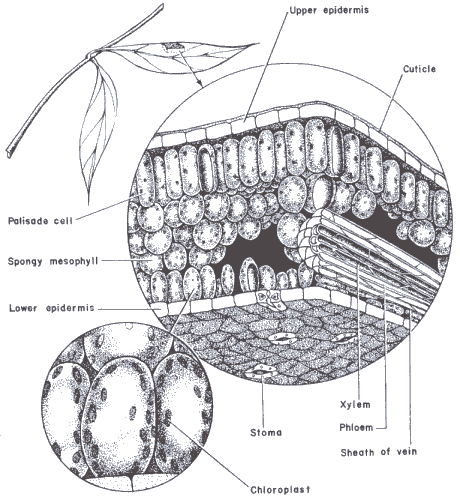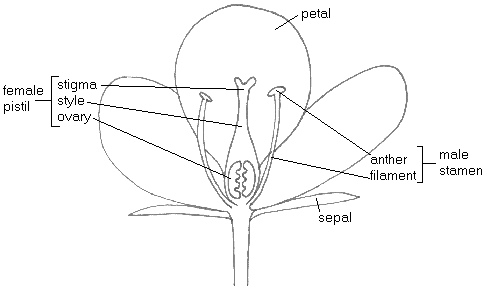
THE ROOT
- The root is the part of the plant that takes in water and minerals for the plant.
- Roots have root hairs that increase the surface area for more water absorption.
THE STEM
- The stem has vessels that transport sap and water throughout the plant.
- Sap is a nutrient-rich fluid that contains a lot of sugar.
THE LEAF
Two Functions of the Leaf
- Photosynthesis is the process whenleaf cells containing chloropyll take in carbon dioxide and water and using sunlight, make sugar and oxygen.
- Transpiration is the loss of water from the leaf. This helps to draw water up through the plant from the roots.
Leaf Cross-Section

- Upper and Lower Epidermis - protective layers on the upper and lower sides of the leaf
- Cuticle - waxy layer on the upper epidermis to reduce water loss
- Palisade Cell Layer - layer without chloroplasts beneath the upper epidermis
- Spongy Mesophyll Layer - layer beneath palisade layer containing chloroplasts which photosynthesise sugars; also contains veins carrying xylem and phloem, and many air spaces for exchange of carbon dioxide and oxygen
- Stoma (Plural: Stomata) - pores in the lower epidermis that are surrounded by bean-shaped guard cells that contain chloroplasts
THE FLOWER

- The flower is the organ of reproduction in flowering plants.
- The male part of the flower is the stamen (composed of the anther where pollen is made and the thin filament).
- The female part of the flower is the pistil (composed of the stigma, the thin style and the ovary).
- Pollination occurs when pollen is transferred by insects or wind from the anther to the stigma. Chemicals called enzymes 'drill' a channel down through the style to the ovary where the egg is.
- Fertilisation occurs when the pollen joins with the egg. After this, a seed forms inside a fruit.
- Germination is the process when a seed grows into a seedling.
HOW WATER AND NUTRIENTS ARE TRANSPORTED
- Transpiration is the water loss that occurs through the open stomata. This loss helps to draw water up through the xylem from the root. Factors that affect transpiration are temperature, light intensity and duration, wind speed and relative humidity.
- Capillary Action - Water moves from the root up to the leaf because of capillary action. This is an adhesive attraction between the water particles and the vessels inside the plant.
- Diffusion - Almost all chemicals inside a plant move from areas where they are in excess to areas where there are insufficient amounts of the chemicals to maintain a balance. For example, water moves from the root up to the leaf, but sugars produced in the leaf by photosynthesis move downwards to the root.